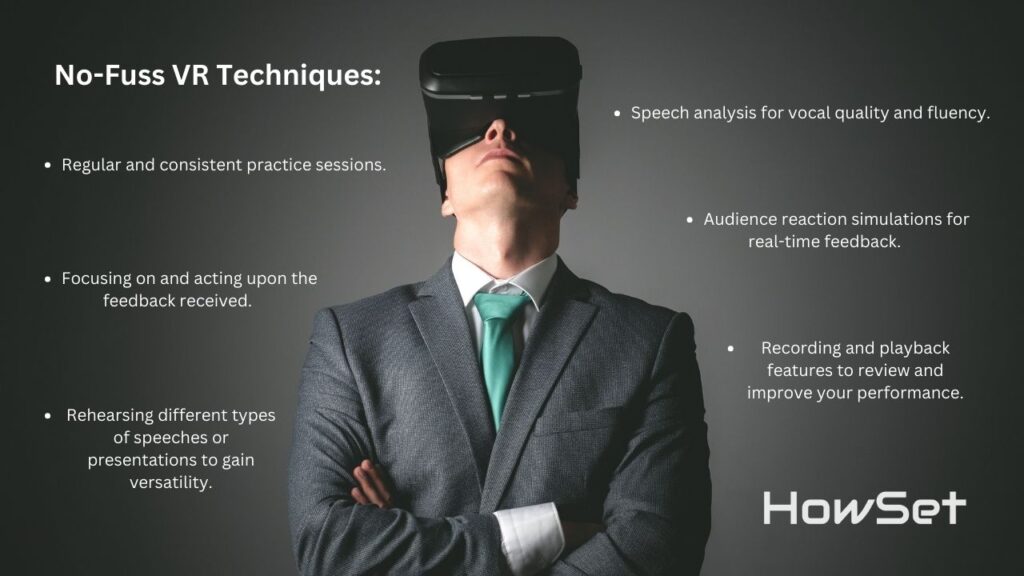Struggling with Public Speaking? Here’s How VR Can Help You Excel
Welcome to the world of public speaking, where nerves can run high, and the spotlight feels hotter than ever. But what if we told you there’s a modern way to master this age-old skill? Enter Virtual Reality (VR) – your new ally in conquering public speaking challenges.
In this guide, we’ll dive into how VR transforms the way we prepare for public speaking. Imagine practicing your speech in a room full of listeners, all from the comfort of your home. VR makes this possible. It’s not just about practicing more; it’s about practicing smarter. With VR, you can face a virtual audience, get instant feedback, and refine your skills without the pressure of a real crowd.
This isn’t science fiction – it’s the new reality of public speaking training. Whether you’re gearing up for a crucial business presentation, a wedding speech, or just looking to boost your confidence, VR offers a unique and effective way to get there. So, let’s step into the virtual world and explore how it can turn you into a more confident and skilled speaker.
Overcoming Public Speaking Anxiety with VR
Do you feel butterflies in your stomach at the thought of speaking in front of people? You’re not alone. Many people feel nervous about public speaking. But guess what? VR can be a game-changer in battling this anxiety.

Why Public Speaking Scares Us
- Fear of being judged
- Worry about forgetting words
- Anxiety from being the center of attention
How VR Helps
- Safe Environment: VR creates a virtual audience, so you practice without real-life pressures.
- Realistic Experience: It feels like you’re speaking to actual people, training your brain to manage real-world nerves.
- Instant Feedback: Get quick tips on your performance, helping you improve faster.
Imagine practicing your speech in a setting that feels real, but without the stress of actual eyes on you. That’s the magic of VR in public speaking. It’s like a rehearsal in a safe yet realistic world where mistakes are okay and learning is fast.
Testimonials Many have turned their fear into confidence using VR. Here’s what they say:
- “VR made me face my fears in a safe place. I’m no longer scared of real audiences!” – Emily R.
- “I practiced my conference speech with VR, and it felt so real. I nailed the actual event!” – Alex T.
By using VR, you’re not just practicing words; you’re building confidence. So, when it’s time for the real thing, you’ll be ready and less anxious. This is how VR is changing the game in public speaking.
Setting Goals and Measuring Effectiveness in VR Training
When using Virtual Reality (VR) for public speaking training, setting clear goals and measuring progress is crucial. This section will guide you on how to establish objectives and assess your improvement effectively in VR training.
Establishing Clear Goals for VR Training
Starting with clear goals is key. When you begin VR training, ask yourself: what do I want to achieve? Your goals could range from reducing nervousness, improving eye contact, to mastering the flow of your speech. By setting specific targets, you guide your practice sessions more effectively.
Goal Examples:
- Reduce the use of filler words (like “um” and “ah”).
- Increase eye contact duration with the virtual audience.
- Achieve a steady speaking pace.
Assessing Progress and Effectiveness in VR
Once you have your goals, the next step is to measure your progress. VR technology offers various tools to track your improvement. These tools can provide data on different aspects of your performance, such as speech clarity, pacing, and audience engagement.
Measuring Tools:
- Speech analysis for clarity and fluency.
- Eye tracking to measure eye contact.
- Audience response simulation for engagement levels.
VR training offers the unique advantage of tracking these metrics over time. You can compare your initial performances with later ones to see concrete evidence of your improvement. This data-driven approach ensures that you’re not just feeling more confident but also objectively getting better.
Designing Content for VR Presentations
Creating engaging and effective content is crucial for VR presentations. This section focuses on how to design content that resonates with your virtual audience and makes your practice sessions more impactful.
Crafting Engaging Content for VR Audiences
When designing your presentation content for VR, think about what will keep a virtual audience engaged. Your content should be clear, concise, and interesting. Use simple language and focus on key points to make your message stand out.
Content Design Tips:
- Start with a strong opening to grab attention.
- Use clear and concise points to maintain engagement.
- Incorporate stories or examples to make your content relatable.
Utilizing Visuals and Interactivity in VR
VR gives you the unique opportunity to use visuals and interactive elements. These can make your presentation more memorable and engaging. Think about how you can use images, charts, or even interactive Q&A sessions to enhance your presentation.
Ideas for Visuals and Interactivity:
- Include relevant images or charts to support your points.
- Use interactive elements like virtual Q&A sessions.
- Experiment with different virtual environments to suit your topic.
By focusing on crafting engaging content and incorporating visual and interactive elements, your VR presentations can become powerful tools for honing your public speaking skills. These strategies not only keep your virtual audience engaged but also prepare you for delivering captivating presentations in real-life scenarios.
Practicing with VR: Techniques and Tools
Using Virtual Reality (VR) effectively for public speaking requires understanding the right techniques and tools. This section will guide you through various VR practices and the tools available to enhance your public speaking skills.

Key Techniques for Effective VR Practice
To make the most out of your VR training, it’s important to focus on specific techniques. First, consistent practice is essential. Regular VR sessions help you gradually get comfortable with speaking in front of an audience. Secondly, focus on the feedback provided by the VR system. This feedback, on aspects like pacing or eye contact, is crucial for improvement.
Effective VR Practice Techniques:
- Regular and consistent practice sessions.
- Focusing on and acting upon the feedback received.
- Rehearsing different types of speeches or presentations to gain versatility.
Tools Available in VR for Public Speaking
VR offers various tools that can enhance your public speaking training. These include speech analysis tools that provide feedback on your vocal quality, pacing, and use of filler words. Additionally, many VR systems feature audience reaction simulations, giving you a sense of how a real audience might respond to your speech.
VR Public Speaking Tools:
- Speech analysis for vocal quality and fluency.
- Audience reaction simulations for real-time feedback.
- Recording and playback features to review and improve your performance.
By utilizing these techniques and tools, you can significantly enhance your ability to speak confidently and clearly. VR provides a unique platform for practice, where you can not only rehearse your speeches but also receive valuable feedback and adjust your approach accordingly, making it an indispensable tool for anyone looking to improve their public speaking skills.
The Impact of VR on Presentation Skills and Anxiety Reduction
Virtual Reality (VR) has a significant impact on improving presentation skills and reducing anxiety. This section will explore the positive effects that VR training has on public speakers.
Enhancing Presentation Skills Through VR
VR training can dramatically improve various aspects of your presentation skills. With VR, you get to work on your voice modulation, body language, and engagement tactics in a realistic yet controlled environment. The immediate feedback and the ability to repeat sessions help in fine-tuning these skills effectively.
Areas of Improvement in Presentation Skills:
- Voice clarity and modulation.
- Effective use of body language.
- Engaging the audience with eye contact and gestures.
Reducing Anxiety with Regular VR Practice
One of the biggest advantages of VR training is its role in reducing public speaking anxiety. By repeatedly practicing in a VR environment, you become more accustomed to the feeling of being in front of an audience, which significantly lowers anxiety over time.
Benefits in Anxiety Reduction:
- Familiarity with the audience setting reduces nervousness.
- Controlled environment helps in managing stress.
- Gradual increase in confidence with each practice session.
The impact of VR on enhancing presentation skills and reducing anxiety is profound. By providing a realistic platform for practice and feedback, VR helps individuals build confidence and refine their speaking abilities, making public speaking a less daunting task.
Enhancing Persuasiveness and Charisma through VR

Virtual Reality (VR) isn’t just about overcoming the fear of public speaking; it’s also an excellent tool for enhancing persuasiveness and charisma. This section explores how VR helps in developing these essential aspects of effective communication.
Building Persuasive Skills with VR
VR provides a unique setting for practicing and refining persuasive skills. Through various scenarios and audience types available in VR, you can learn how to adapt your message and delivery to different situations. This practice helps in understanding what makes a speech persuasive and how to achieve it.
Key Aspects of Building Persuasiveness in VR:
- Tailoring the message to suit different virtual audiences.
- Experimenting with tone and emphasis to see what impacts the audience more.
- Practicing persuasive speech techniques in diverse scenarios.
Developing Charisma in a Virtual Environment
Charisma in public speaking often comes down to how confidently and engagingly you present your ideas. VR’s immersive environment allows you to practice these aspects repeatedly. You can experiment with various styles of delivery, storytelling techniques, and engaging narratives to find what works best for you.
Enhancing Charisma Through VR:
- Using storytelling to connect with the virtual audience.
- Experimenting with different speaking styles to find your unique charisma.
- Practicing engaging narratives to hold the audience’s attention.
By practicing in VR, you’re not only overcoming fears but also equipping yourself with the art of persuasive and charismatic speaking. VR offers a safe and diverse platform to experiment and discover the speaking style that best suits your personality, making your real-world presentations more impactful and memorable.
The Future of Public Speaking Training with VR
Virtual Reality (VR) is set to revolutionize the way we approach public speaking training. With each passing day, technology advances, and VR becomes more capable, more immersive, and more accessible. In this section, we will explore what the future might hold for VR in the realm of public speaking.
Evolving VR Features for Enhanced Training
As VR technology continues to evolve, we can anticipate more advanced and immersive features. Imagine VR systems that offer incredibly realistic audience reactions, or virtual environments that perfectly mimic every kind of speaking venue, from a small meeting room to a vast auditorium. We might also see the introduction of AI-powered speech coaches within VR, providing tailored training and feedback based on individual performance.
The future of VR in public speaking could involve scenarios so realistic that they are virtually indistinguishable from real life. This advancement would enable speakers to practice in an array of situations, ensuring they are well-prepared for any speaking engagement.
Expanding Access and Integration in Education and Beyond
The future also holds promise for the wider accessibility of VR public speaking training. As VR headsets become more affordable, this technology will be within the reach of a larger audience. This democratization of VR tools means that more people than ever before will have the opportunity to enhance their public speaking skills in a way that was not previously possible.
Moreover, we can expect to see VR public speaking training integrated into educational curricula. From primary schools to universities, VR could become a standard tool for teaching communication skills. Beyond education, businesses and professional training programs are also likely to adopt VR as a key component of their training methodologies.
Conclusion
The integration of Virtual Reality (VR) in public speaking training is a groundbreaking development that offers immense benefits. From providing a safe and realistic environment to practice and receive immediate feedback, to enhancing key skills like persuasiveness and charisma, VR is revolutionizing how we approach public speaking. As VR technology continues to evolve, it promises even more advanced features, making training more immersive and effective. With its potential for wider accessibility and integration into educational systems, VR is poised to become a fundamental tool in developing effective communication skills for diverse audiences. The future of public speaking training with VR is not only exciting but also holds the promise of making confident and skilled public speaking accessible to all.


Leave a Reply